- Home/
- GATE ELECTRICAL/
- GATE EE/
- Article
Three-Phase Transformer [Gate Notes]
By BYJU'S Exam Prep
Updated on: September 25th, 2023

The Three Phase Transformer is advantageous in terms of cost, and they offer effective operating conditions. The modern-day scenario of the power system is significantly tilted toward the three-phase systems in every stage of its operation that is the generation, transmission, distribution, and the lion’s share of the load in the form of industries. So, in every stage of these operations, the three-phase transformer has a crucial role to play, hence it must be adapted to these changes.
In this article, we will discuss the basic construction of three-phase transformers, the basic connections which are the Wye-Delta Connection, Delta-Wye Connection, Delta-Delta Connection, and Wye-Wye Connection.
Table of content
What is a Three-Phase Transformer?
The Three-Phase Transformer is a transformer made up of three sets of primary and secondary windings. They operate as an electrical system that has three-phase. The three-phase transformers can be constructed in two ways, one is three identical single-phase transformers are connected to form a three-phase transformer bank, or else a single unit of a three-phase transformer with the windings of three phases wound on a single core.
Nowadays three-phase transformer banks are rarely in use as a single unit of a three-phase transformer is lighter, cheaper, it occupies less physical space. However, still, there are significant installations of the three-phase transformer banks.
Construction of Three-Phase Transformer
The three-phase transformer can be constructed in a single unit by placing the primary and secondary winding of all three phases in a single core. This can be done by using either a three-phase core type or three-phase shell-type construction.
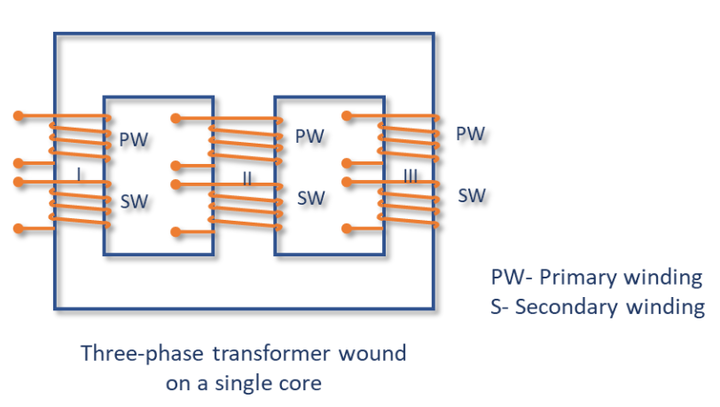
The above diagram shows a three-phase core type transformer wound on a single-core. In the figure, the windings are placed one above the other but in reality, the low voltage winding is placed adjacent to the core, and the High voltage winding is placed over it with proper insulation. In the other way, we can connect three identical, single-phase transformers connected in either wye or delta to form a three-phase transformer bank as shown below.
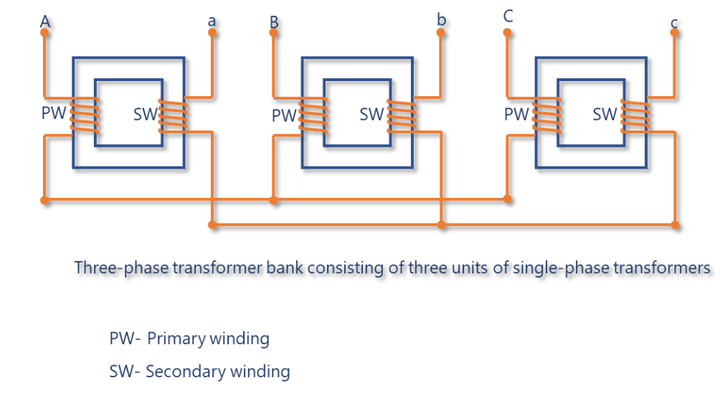
Three-Phase Transformer Connections
The three-phase transformer is either a single unit with the windings of all three phases wound on a single core or the three-phase transformer bank with three individual transformer units, the primary and secondary windings can be connected either in a wye (Y) or delta connection. Hence four different connections of primary and secondary windings are possible, they are namely
- Wye – Wye Connection (Y-Y)
- Wye-Delta Connection (Y-Δ)
- Delta-Wye Connection (Δ-Y)
- Delta-Delta Connection (Δ-Δ)
The main objective is
- To analyze how the connection patterns of three-phase transformers are influencing the per phase parameters of the transformer and To analyze how the harmonics induced in the three-phase system will affect the operation of the transformer.
To understand this, we must have the basic idea of harmonics induced in the wye and delta connections. It is to be noted that
- In the wye connection, there is no possibility of triple harmonic currents either in phases or lines but there is the possibility of third harmonic voltages in phases, but not across the lines.
- In the delta connection, there is no possibility of triple harmonic voltages either in phases or across the lines but there is the possibility of third harmonic currents in the phases but not through the lines.
- In the single-phase transformer, due to the nonlinearity of the core, the no-load current is a peaky sinusoid, hence there is a possibility of having a third harmonic component in the no-load current, this, in turn, helps us in obtaining the sinusoidal flux in the core. That is the core flux is free of the third harmonic component and so is the induced voltage.
Wye-Wye Connection (Y-Y)
In this connection, both the primary and secondary windings of the transformer are connected in the wye connection as shown in the figure.
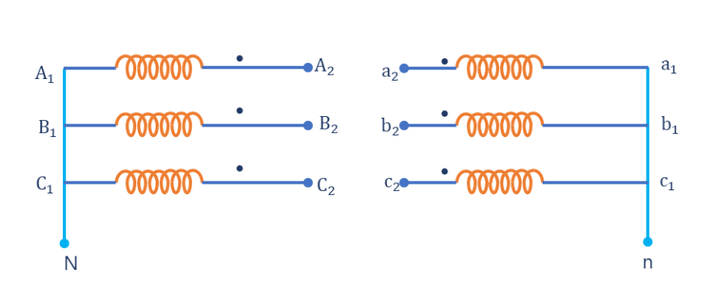
The above figure shows the Y-Y connection of a three-phase transformer with zero degrees phase shift, we can also connect it with a 180 phase shift, and we can discuss it further in our lectures under the topic of the phasor groups.
Let E1 and E2 be the per phase voltage on the primary side and the secondary side. Similarly, El1 and El2 be the line voltages on the primary side and secondary side.
Then the transformation ratio
k =E1/E2
We know that in wye connection line voltage is √3 times the phase voltage
⇒k = E1/E2 = (El1/√3)/(El2√3)
There are some serious disadvantages associated with the Y-Y connection, they are
- The voltage in the phases will be severely unbalanced, during the presence of unbalanced loads.
- The significant presence of the third harmonic component in the voltage will increase the stress on the insulation and even leads to the breakdown of the insulation.
As there is no possibility of having the third harmonic component in the no-load current, hence there is a possibility of the third harmonic component in the flux, which may lead to the presence of a triple harmonic component in the voltage.
The problem associated with the unbalanced loads can be solved by using solid neutral grounding, the neutral will also provide the path for current imbalances in the load. On the other hand, the third harmonic component in the voltage can be suppressed by using a tertiary delta winding on the same core.
Wye-Delta Connection
The connection diagram of a three-phase Y-transformer is shown below. The Y-Connection is preferred in the applications that demand the stepping-down of the voltage, as it offers almost 43 percent less stress on the insulation on the HV side as the phase voltage is 57.7 percent of its line voltage in the wye connection.
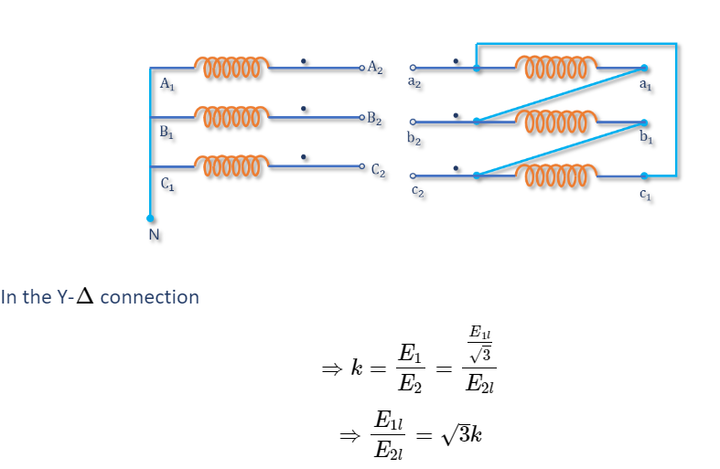
The presence of delta winding can nullify the effect of the third harmonic component in the voltages, as they can be consumed in the form of circulating currents inside the delta winding. But the problem associated with this connection is the secondary voltage of the transformer shifted to 30º relative to the primary voltage, this will cause problems during the parallel operation of transformers. During the parallel operation, the phase angle of the transformer secondaries must be the same, so we have to take care of this phase shift while connecting the transformers in parallel.
Delta-Wye Connection
The below figure shows the interconnection of a three-phase transformer in a delta-wye connection. In general, this connection of the three-phase transformer will be preferred in the applications where we need to stepping-up the voltage levels. With the neutral grounding employed on the wye side, this connection can also be used in distributed applications.
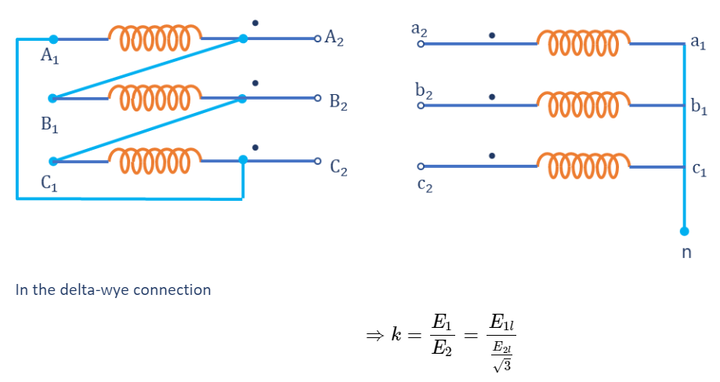
Like the wye-delta connection of a three-phase transformer, the delta-wye connection also has immunity from the third harmonic component in the voltage. This connection also induces a phase shift of 30º, as the secondary winding lags the primary voltage by 30º in the above figure.
Delta-Delta Connection
The delta-delta connection can be employed in low-power applications as both sides have to handle the line voltage. The following figure can give the basic idea of the connections.
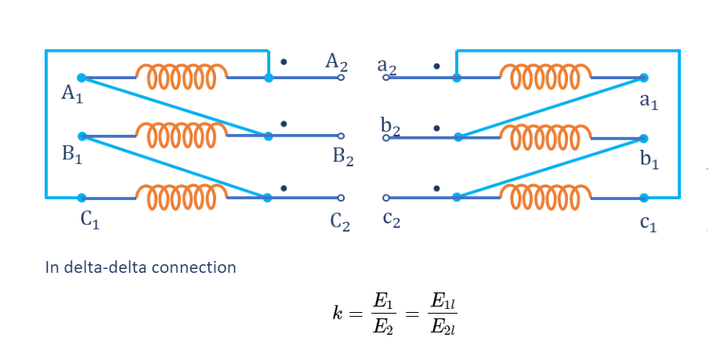
This connection of the three-phase transformer has the advantage that one transformer from the bank can be removed for repair or maintenance with the other two transformers functioning as s three-phase transformer bank with 57.7 percent of the earlier capacity. This connection is known as open-delta or ‘V’ connection.


